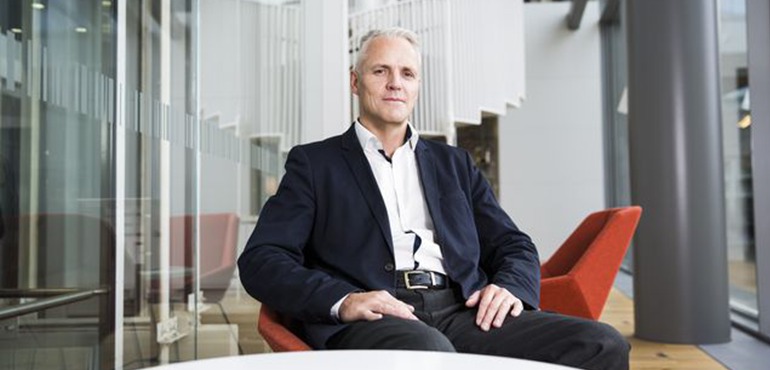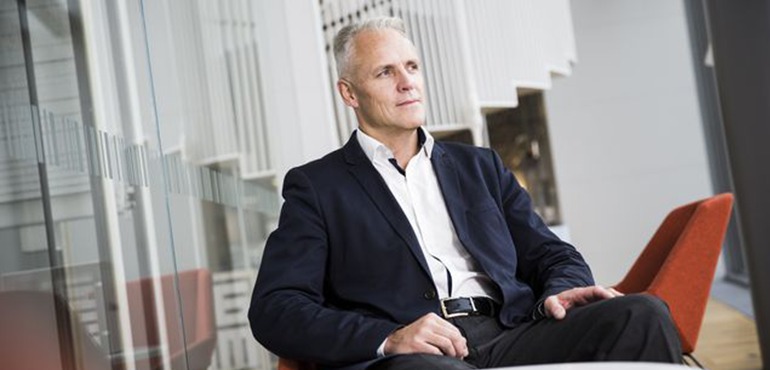
Media in turmoil
Jukka Viitasaari, Managing Director at the Federation of the Finnish Media Industry, is in a great position to understand the reasons and consequences of the troubles that the media sector is facing and also to discuss how its condition could be improved.
The media is going through tumultuous times in Finland and everywhere else in the world. This is evident in the news of ongoing cooperation and reorganisation negotiations.
“These are the result of megatrends, globalisation and digitalisation. The goods that the media sell are immaterial, and this is why it has been one of the first sectors to be affected by digitalisation in that it is pressured to adjust,” says Jukka Viitasaari, Managing Director at The Federation of the Finnish Media Industry.
For more than a hundred years, the two sources of income for print media have been selling subscriptions and advertising. Since they are both facing serious challenges now, it is not surprising that the industry is in a critical situation.
“In Finland the situation was deliberately made worse. The decision by the Katainen cabinet to increase the VAT from zero to ten percent was made at a bad time, and it also felt like payback. We should really discuss the freedom of media, not just that of the Finnish Broadcasting Company Yle, from political decision-making.”
Changing consumer behaviour
People no longer subscribe to newspapers and magazines as much as they used to. This process has been accelerated by the prolonged financial crisis, which Viitasaari says is primarily self-inflicted. Subscriptions are among the first to go when consumers need to cut back their spending.
There are other changes in consumer behaviour as well. People read less as they spend more time on visual media channels and lead more hectic lives in general.
“Yet you could also say that people are somehow more empowered as everyone produces media content. Blogs and vlogs are great, though they don’t offer any fact-based professional journalism but mostly opinion-based stories.”
Jukka Viitasaari explains that media”s problems have been made worse by megatrends and deliberate decisions. Increasing the VAT rate was one of the disastrous decisions.
Media have also lost their role in setting daily routines due to cloud services. People don’t gather to watch the news now that programmes can be streamed 24/7. The current sharing economy also poses challenges to media and their finances. The content is purchased once, then shared numerous times, which often involves piratism and copyright breaches.
“Of course there is still need for trustworthy, credible and factual content. In the flood of content people would surely like to be able to tell fact from fiction. We should find a way to persuade people to pay for fact-based content, which they are used to accessing for free.”
Competition is unfair
Fair competition as well as division of labour between the private and public sectors is another hot topic. Representatives of commercial media think that Yle, which is funded by the taxpayer, distorts competition, and the same applies to Posti, which has the monopoly on delivery services.

“European companies pay producers for content while Americans collect the profits. It is a little odd,” Viitasaari describes the revenue model applied by Facebook, Google and similar companies. The publisher’s copyright might be the answer.
Another type of competition comes from international services such as Facebook, Google and YouTube, which do not follow conventional operational models. They share content produced by other providers and turn it into business that relies on revenue from advertising. Some of the content is produced by people who have agreed to share it but there is a lot of content that is protected by copyright.
“Facebook and Google alone take half of the online advertising revenue generated in Finland,” says Viitasaari.
“They are not subject to the same restrictions concerning advertising as Finnish media. A classic example is the advertising of alcoholic drinks. Finnish TV channels and radio stations are only allowed to broadcast ads for alcoholic drinks after ten in the evening whereas such restrictions do not apply to Facebook and similar companies. Competition can’t be fair in this situation. It is the authorities’ duty to ensure that all companies are equal.”
Can the EU influence VAT rates on digital content?
Fortunately, the Federation of the Finnish Media Industry and the media sector can offer suggestions to improve the situation.
Firstly, VAT on editorial content should always be the same, regardless of whether it appears in print or digital media. Now a higher VAT rate is applied to digital content.
“President of the European Commission Jean-Claude Juncker has said that he understands the harmful effects of VAT on digital content so we are hopeful that something will be done, specifically that it will be reduced. This decision may be made at the EU level as early as 2017 or 2018. Nothing would then prevent Finland from dropping the VAT rate on editorial content to the lowest rate possible, which hopefully is zero,” says Viitasaari.
The EU should also promote internal digital markets to ensure that European media companies do not have bigger barriers than their competitors based outside the EU. Viitasaari explains that European companies must comply with over-protective rules concerning issues such as consumer protection.
“One issue that we have been lobbying for in the EU is a new type of publisher’s copyright that would suit the digital era. For example, if large newspapers had the copyright for the editorial content, they could contact companies such as Google with the data of how many times Google has linked their stories and images. Google would then have to pay the papers X million euros in order to be able to operate in Europe. This would mean that those who produce, pay for and own the content would receive some revenue from activities that these companies benefit from.”
Viitasaari believes that if this model was introduced in Europe, the rest of the world would soon follow.
Fairer restrictions on advertising
In Finland the Federation of the Finnish Media and commercial media has been lobbying for the clarification of the role of Yle and, consequently, readjusting its funding to reflect its role. They want to have an independent body to monitor public broadcasting services’ impact on the market.
“Free competition should also be allowed in delivery services. It cannot be right that Posti uses its monopoly status to raise prices by more than 20 percent overnight.”
Decision-makers could loosen the restrictions on advertising so that the rules would be fair for all companies based in Finland or elsewhere. Further restrictions should be considered very carefully.
“We are confident that this government understands better than the previous ones the importance of Finnish-owned media that operate here either in Finnish or Swedish. I’m sure that something will happen next spring after Vanjoki’s task force delivers its report in December and the parliamentary task force delivers its report early next summer. But this is all just talk, it is action that counts.”
Federation lobbies for changes in media’s operating environment
To the public, the Federation of the Finnish Media Industry appears as an organisation that publishes expert opinions. Viitasaari explains that the Federation’s main lobbying method is to meet decision-makers as early as possible so that its members’ views can be made known before the decisions are made.
“If they end up making stupid decisions, at least they do so knowingly,” he says.
Viitasaari thinks that the Federation is like a cost item in the profit and loss account: it tries to minimise costs, remove restrictions and make its operating environment fairer and more competitive. The income items such as investments and innovation are mainly dealt with by the member organisations.
The Federation also uses various channels to share its views. Viitasaari describes himself as a messenger who focuses on the positive side of digitalisation.
“I have also highlighted the strength of the printed media. Everyone swears by digital media but it would be best to combine print, digital and mobile media with face-to-face meetings and other channels depending on the context. Using hybrid media is the best way to get your message to the public.”
Two task forces exploring the media sector
The Minister of Transport and Communications Anne Berner set up a task force in August 2015 to explore the operational conditions, barriers and competition in the Finnish media market. The task force is led by Anssi Vanjoki, and it is expected to deliver its report in early December. The Federation of the Finnish Media Industry and key media companies provided the task force with their suggestions.
Alma Media”s statement for the Federation”s media market task force (in Finnish):
http://www.lvm.fi/lvm-mahti-portlet/download?did=182731
Yle”s role is being explored by a parliamentary task force led by Arto Satonen, MP. The task force”s term will end on 31 May 2016.